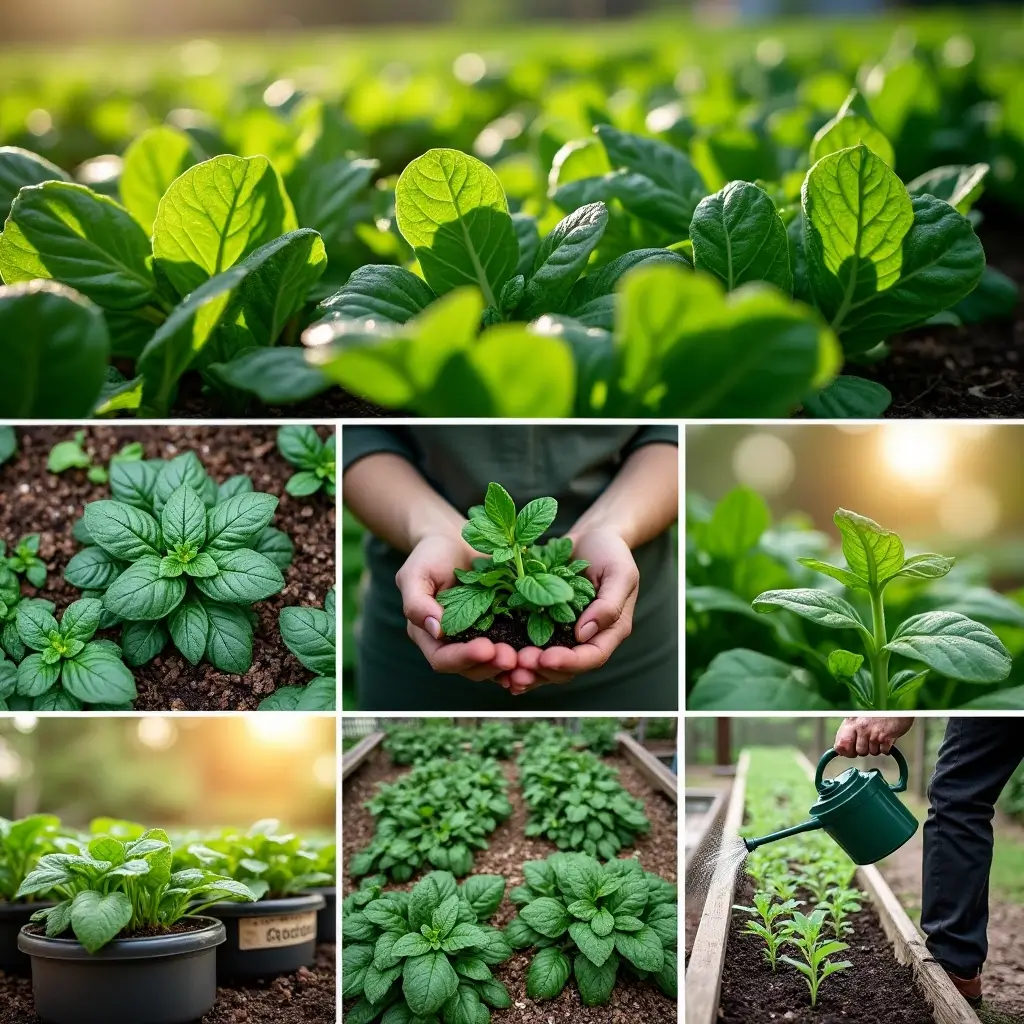How to Grow spinach in your garden can be one of the most rewarding experiences for a gardener, whether you have an expansive backyard or just a small balcony space. Fresh spinach is a nutrient powerhouse, packed with vitamins and minerals that make it a great addition to your meals. This comprehensive guide will walk you through everything you need to know about how to grow spinach, from selecting the right variety to harvesting your lush, green leaves.
The Joy of Growing Spinach at Home
Imagine stepping outside and picking fresh spinach leaves straight from your garden. It’s not just satisfying, but also beneficial for your health and your wallet. Growing spinach is a perfect way to bring fresh greens into your home while embracing the rewarding experience of gardening. This guide will help you navigate each step to ensure your spinach plants thrive from seed to harvest.
Why Grow Spinach?
Before we dive into the details of how to grow spinach, let’s discuss why this leafy green is so popular among gardeners and chefs alike:
- Health Benefits: Spinach is loaded with iron, calcium, vitamins A and C, and antioxidants that support overall health and well-being.
- Versatile in the Kitchen: From salads and smoothies to soups and omelets, fresh spinach can enhance any meal.
- Fast-Growing and High Yield: Spinach grows quickly, which means you can enjoy multiple harvests in a single season if planted at the right times.
- Adaptable: Spinach can be grown in gardens of any size, whether you have a large backyard or a few pots on your windowsill.
Choosing the Right Variety of Spinach
Choosing the right spinach variety is crucial for a successful harvest. Here are the most common types you should consider:
Traditional Leafy Spinach (Spinacia oleracea)
This is the most common type of spinach and is popular for its tender, nutrient-rich leaves. Some well-known varieties include:
- Bloomsdale: A classic variety known for its curly leaves and resistance to bolting.
- Tyee: A reliable option that is tolerant of cool temperatures and has a smooth leaf texture.
- Regal: Ideal for early planting and known for its robust growth.
Perpetual Spinach (Leaf Beet or Chard)
Unlike traditional spinach, perpetual spinach is actually a type of chard. It’s great for those who want a longer harvest season because it continues to produce leaves throughout the year. However, its flavor can be slightly different, with a more beet-like taste.
Heat-Resistant Varieties
Spinach is sensitive to warm weather and can bolt (go to seed) when temperatures rise. To prevent this, you might want to opt for heat-tolerant varieties:
- Summerlong: This type is bred to withstand higher temperatures without bolting.
- Matador: Another heat-resistant variety with excellent resistance to disease.
Quick Comparison Table for Spinach Varieties
| Variety | Ideal for | Flavor | Key Feature |
|---|---|---|---|
| Bloomsdale | Spring and fall plant | Mild and sweet | Curly leaves, slow bolting |
| Tyee | Early spring planting | Smooth, tender | Cold-tolerant, high yield |
| Regal | Spring planting | Slightly sweet | Fast-growing, compact |
| Summerlong | Warm weather | Mild | Heat-resistant |
| Matador | Warmer climates | Neutral | Disease resistance |
Preparing Your Garden for Spinach

Setting up your garden properly is key to a successful spinach crop. Here’s how to prepare:
Ideal Growing Conditions
Spinach prefers well-draining soil that’s rich in organic matter. Here’s what you should know:
- Soil Type: Use soil that’s rich and loamy, which holds moisture but doesn’t become waterlogged. If your soil is heavy clay or sandy, amend it with compost or aged manure to improve its quality.
- pH Level: The ideal pH for growing spinach is between 6.5 and 7.0. Test your soil and adjust with lime or sulfur as needed.
- Sunlight: While spinach prefers full sun, it can still grow in partial shade. This is especially true in warmer climates where afternoon shade can prevent bolting.
How to Improve Your Soil
- Amend with Compost: Mix 3 inches of aged compost or organic matter into the top 6 inches of soil before planting.
- Organic Fertilizers: Add organic fertilizers rich in nitrogen to promote leafy growth.
- Mulching: Use mulch around the plants to retain moisture and regulate soil temperature.
Planting Spinach: A Step-by-Step Guide
Knowing when and how to plant your spinach will set the foundation for your success.
Timing and Sowing
- Spring Planting: Plant spinach 4-6 weeks before the last expected frost. This gives the plants a head start and helps them grow before the days get too long and warm.
- Fall Planting: Plant again 6-8 weeks before the first expected frost to ensure you get a harvest before winter sets in.
Sowing Techniques
- Spacing: Plant spinach seeds 2.5 cm deep and space them 20 cm apart to give the leaves ample room to grow.
- Row Planting: Space rows 30 cm apart for easy access and to allow plants to grow freely.
- Direct Seeding: Sow seeds directly into the garden bed to minimize transplant shock.
Indoor vs. Outdoor Sowing
You can start spinach seeds indoors to get a head start, especially if your growing season is short:
- Indoors: Use seed trays with good drainage and a high-quality potting mix. Place the trays under a grow light or near a bright window to ensure they get enough light.
- Outdoors: Sow directly into prepared garden beds or containers once the soil can be worked and the danger of frost has passed.
Caring for Your Spinach Plants

Caring for your spinach plants properly ensures healthy growth and a bountiful harvest.
Watering Requirements
Spinach needs consistent moisture to thrive:
- Frequency: Water deeply about once or twice a week, depending on weather conditions. Aim to keep the top 2-3 inches of soil consistently moist but not soggy.
- Morning Watering: Water in the morning to allow leaves to dry during the day and prevent fungal diseases.
Fertilizing for Healthy Growth
To achieve the best growth, fertilize your spinach regularly:
- Choose the Right Fertilizer: Opt for a water-soluble, organic fertilizer such as a balanced 10-10-10 mix or one that’s higher in nitrogen.
- Application: Fertilize once when the seedlings are about 4 inches tall and then again midway through the growing season.
Mulching and Weeding
- Benefits of Mulching: Helps maintain soil moisture, suppresses weeds, and moderates soil temperature.
- Weeding Tips: Regularly remove weeds by hand or use a hoe to keep your garden weed-free and reduce competition for nutrients.
Troubleshooting Common Problems
Like any plant, spinach can face a few challenges. Here’s how to handle them:
Dealing with Bolting
Bolting occurs when spinach tries to produce seeds due to long daylight hours or high temperatures:
- Plant Heat-Resistant Varieties: Choosing varieties like Summerlong or Matador can help.
- Shade and Water: Ensure your plants are shaded during the hottest part of the day and that they are adequately watered.
- Early Planting: Start planting early enough to harvest before the days get too long.
Pest and Disease Management
Spinach is prone to pests like aphids and flea beetles, as well as diseases like downy mildew:
- Pest Control: Use organic methods such as neem oil or insecticidal soap to manage pests.
- Disease Prevention: Plant spinach in well-ventilated areas and avoid overhead watering to minimize fungal issues.
Winter Protection
Spinach is hardy and can survive cold temperatures, but it helps to take precautions:
- Cold Frames: Use cold frames to protect your spinach during winter and get an early spring harvest.
- Mulching with Hay: Apply a layer of mulch to insulate the plants and prevent freezing.
Harvesting and Enjoying Your Spinach
Knowing when and how to harvest spinach ensures that you enjoy the best-tasting leaves while encouraging the plant to keep producing.
Signs of Maturity
Your spinach is ready to harvest when the outer leaves are large enough to be picked. Look for leaves that are 3-4 inches long for optimal flavor and texture.
Best Practices for Harvesting
- Harvesting Method: Pick the outer, mature leaves first. This encourages the plant to produce more leaves from the center.
- When to Harvest: In spring, harvest before the plant bolts to prevent the leaves from becoming bitter.
Recipe Ideas Using Fresh Spinach
Here are some quick recipes to try once your spinach is ready:
- Spinach Salad: Toss fresh spinach with cherry tomatoes, sliced cucumber, and a light vinaigrette.
- Sautéed Spinach: Cook fresh spinach in olive oil with minced garlic for a simple, delicious side dish.
- Spinach Smoothie: Blend a handful of spinach with banana, yogurt, and a touch of honey for a healthy, energizing drink.
FAQs:
Is spinach easy to grow?
Yes, spinach is relatively easy to grow, especially in cooler weather. It thrives in well-drained, fertile soil and requires regular watering and some protection from pests. With the right care, you can enjoy a bountiful harvest in a short period.
How long does it take to grow spinach?
Spinach grows quickly, typically taking around 4-6 weeks to reach harvestable size. Baby spinach can be harvested in as little as 30 days, while mature plants may take up to 50 days to fully develop.
What is the secret to growing spinach?
The secret to growing spinach is providing it with cool temperatures, consistent moisture, and nutrient-rich soil. Plant spinach early in the spring or in late summer for fall harvest to avoid the heat of summer, which can cause it to bolt (flower prematurely).
Will spinach grow back after cutting?
Yes, spinach can regrow after cutting, especially if you use the “cut and come again” method. By harvesting the outer leaves and leaving the inner ones to grow, you can get several harvests from one plant before it starts to bolt.
A Rewarding Endeavor Worth Trying
Growing spinach is a simple yet gratifying gardening project. Whether you want a steady supply of fresh greens or to experiment with home-cooked recipes, knowing how to grow spinach can transform your gardening and dining experience. Take the time to set up your garden properly, choose the right varieties, and provide consistent care for your plants, and you’ll be rewarded with healthy, nutrient-rich spinach that’s perfect for any meal.
Are you ready to start growing spinach? Share your experiences or ask any questions you have in the comments below. Happy gardening!


